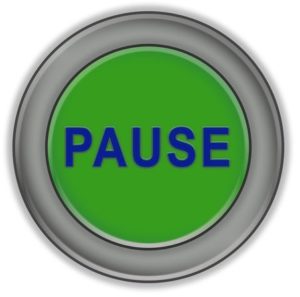By Dr. Ken Broda Bahm:

One after another, like dominos, court systems are shutting down or moving to drastic restrictions. In the process, court dates are being pulled and cases are moving into limbo. As that happens to your own once trial-bound cases, you think, “What now?” What do you do with the time that you now unexpectedly have as your case is put on pause?
Clients will often issue a “Stop work” notice, thinking, “Let’s put a pin in it, package everything so it’s fresh, then revisit the situation down the road, closer to the new date.” Limiting the expenses is, of course, a worthwhile goal, particularly now that the economy is moving into limbo as well. But sometimes, the decision to call an abrupt and complete halt can be more penny-wise than actually wise. When a pause is created, not just by the current Coronavirus measures, but by any delay or uncertainty over a court date, that pause can be an opportunity. In this post, I will share seven ideas on how to make the best use of an unexpected delay.
1. Check In With Your Clients
Not a lot of things about the current Coronavirus status are normal. But the sudden removal of court dates — to litigators, that actually is kind of normal. But not so to many clients. Imagine a doctor-defendant in a medical lawsuit: The case has now drug on far longer than expected, and now on the eve of trial, it is suddenly back into the waiting phase. That uncertainty, added to the litigation stress that was already there, can be a toxic mixture. So, use the delay as an excuse to check in on your clients, not just on the continuing legal issues, but also on the psychology and stress of it all: How are they doing? What do they need?
2. Take a Fresh Look at Settlement
A pause in your chances to resolve the case in a courtroom should at least raise the question of whether the case might be better resolved in a conference room. It is a truism that cases proceed to trial when one side or the other side is substantially mis-reading their chances for success. A pause in the trial schedule can be a chance to step back, and make sure it isn’t you who is being too optimistic. The delay also imposes its own cost, so it is important to factor that cost into the settlement calculation.
3. Recover the Story in Your Case
In complex litigation, the movement toward trial is all about the accumulation of details. As you near the time for the actual trial, the accumulation can be quite thick. So if you do have a chance to step back, use that time to return to the core story that you started with, and make sure you remember how to deliver the narrative in ten minutes or less in a way that accounts for the facts as they’ve evolved.
4. Have a Strategy Session
While a case is in limbo, the daily activity of the trial team will naturally decline. Nonetheless, it is still important for everyone to keep their head in the game to some extent. One relatively low-cost way to do that is to hold a strategy session. Bring together those who know the evidence, the story, and the strategy, and revisit your strengths and weaknesses, and your main messages. With modern tools, it is now easy and effective (not to mention virus-safer) to conduct these meetings using web conferencing along with video-conferencing.
5. Develop Your Visual Case
Good concepts for graphics can often be delayed until you’re nearly at trial. In the crush of other deadline-driven pretrial activities, the demonstrative exhibits sometimes take a back seat. So, if your trial is suddenly delayed, it is a good time to step back and ask, “How are we set for graphics? What about those ideas we had early on that we never fully fleshed out? Do we have a good timeline? Are there other themes that now figure strongly in our case that could be represented visually?”
6. Get Another Pair of Eyes
In a current situation, it is likely that you aren’t the only ones who are being suddenly shifted into idle. For that reason, it might be an ideal time to ask a newly freed-up colleague to give you case a look at to share that fresh perspective. Getting a second opinion can be an excellent way to check your own assumptions and gain some additional ideas without a great investment of time or expense.
7. Revisit the Witnesses
Another factor of trial preparation that can take a back seat in a rushed run up to trial are your witnesses. You have to definitely meet with them to prepare, but have you done everything you can to ensure that they don’t just know what to expect, but are ready to excel? It isn’t just a matter of knowledge, but a matter of practice. So, instead of telling your witnesses that you will reconnect in a few months once you have a date, use that time to squeeze in a practice or two. And in the current spirit of “social distance,” remember that a witness preparation by videoconference can be nearly as effective.
______
Other Posts on Case Preparation:
- Think About Your Case Like an Investor
- Make it Hard on Yourself: Eight Ways to Make Your Mock Trial a ‘Worst-Case’ Test
- Predict With Care: Adapt to Overconfidence in Case Assessment